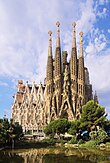Levantine Gothic: Difference between revisions
Jump to navigation
Jump to search
Content deleted Content added
←Created page with 'thumb||right|Porta dels Apòstols of the [[Cathedral of Valencia, a great example of Levantino Gothic.]] [[File:Santdomenec claus...' |
(No difference)
|
Revision as of 03:49, 1 April 2011


It is called the Levantine Gothic to the developed in the Mediterranean area of Spain, the architecture characterized by its halls and churches of great horizontal extent with emphasis on the structural part supported by buttresses and minimal and austere decorations.
The main differences with Castilian Gothic are:
- Single nave instead of three, in case that there, are has the same height and the wider central.
- Chapels between the buttresses.
- Thinner supports.
- Low figurative decoration, dominated by the geometric type.
- Minor surface of openings, resulting in a low light penetration.
Almost all the important buildings are in the capitals, where cathedrals were erected in the 13th and 14th centuries, as in the field abounded the Moors, predominantly the Christian in the cities.
Many buildings of this architectural style are located around all Valencian Community, Balearic Islands and surroundings.
References
- Valdearcos, Enrique: «El arte gótico» Clio n.º 33 (2007) ISSN: 1139-6237
